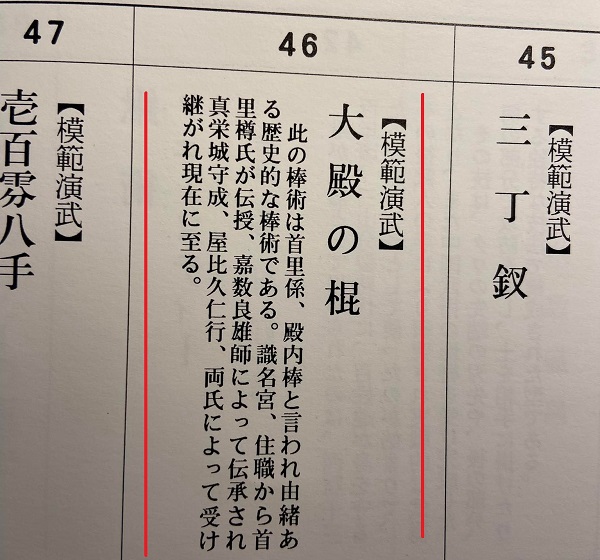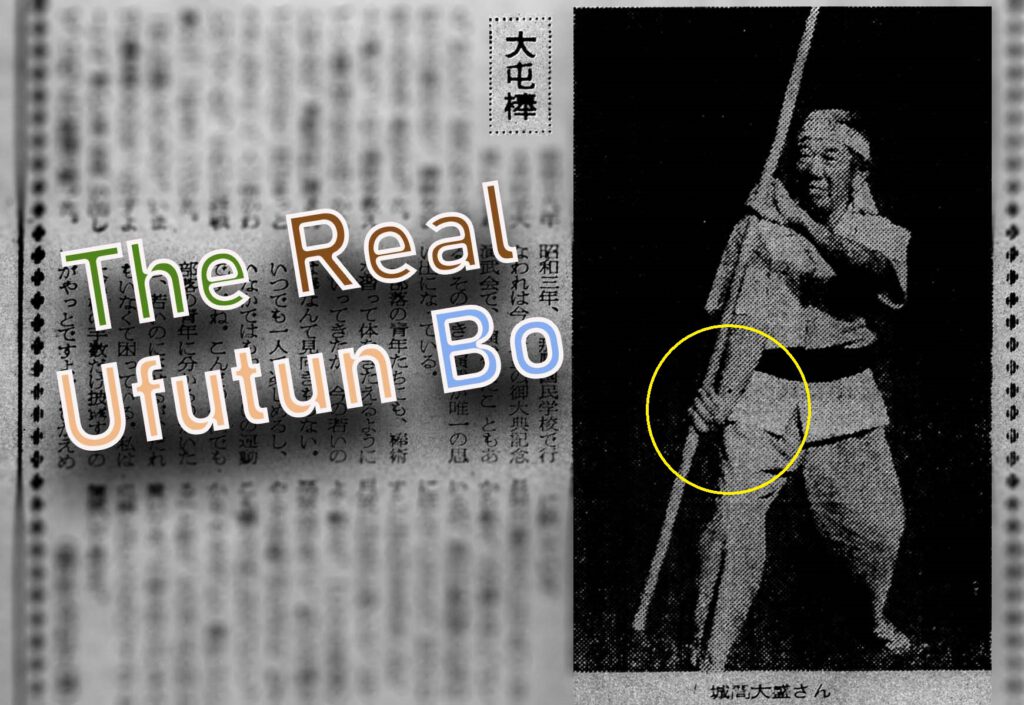Obviously there are two names used, namely Ufutun Bō, which seems to be the current official designation, and Ufutun no Kon. How Ufutun was introduced to the Matayoshi Kobudō collection was described as follows in 1999.
Ufutun no Kon
This bōjutsu is said to be of the Shuri lineage and is also called Tunchi Bō. It is a historical bōjutsu with a long history. It was handed down from the abbot of the Shikina Shrine to Mr. Taru from Shuri, and was handed down by master Kakazu Yoshio and inherited and handed down to the present day by both Maeshiro Shusei and Yabiku Hitoyuki.
In short, it is described as an ancient bōjutsu of the persons in the rank of a Tunchi, that is, medium-level Okinawan samurē families from Shuri, a story well in line with many people’s ideas about the origin of bōjutsu. Then the description says that it came from the abbot (i.e., the chief priest of a Buddhist temple) of Shikina Shrine (which is a Shintō shrine), so here is a terminological contradiction. Anyway, from Shikina Shrine it was handed down to a person named “Mr. Taru from Shuri,” wherein Taru in case of nobles was only used as a childhood-name, but it might have been carried on by a commoner, and since commoners had no family names during the kingdom era, this might have been the case. This Taru then taught it directly or indirectly to a certain Kakazu Yoshio, who further handed it down to Maeshiro Shusei and Yabiku Hitoyuki.
The most important thing to note here, however, are the characters used for writing Ufutun no Kon 大殿の棍. This Ufutun no Kon means “the nobleman’s staff fighting techniques,” and it fits the above shown description of 1999. In short, both name and description of Ufutun no Kon as of 1999 made a connection to Shuri officials and noblemen.
However, today the kata name is written with different characters, namely Ufutun Bō 大屯棒, meaning the “the staff fighting techniques of the place Ufutun,” which refers to the place today pronounced Oton in Yaese, Shimajiri district in southern Okinawa.
In other words, the characters used to wrote Ufutun were changed, and by this act the context of the kata’s origin and history also changed completely. That is, because Ufutun Bō is a village bōjutsu of the place Ufutun (Oton) now located in Yaese, Shimajiri district in southern Okinawa.
Looking further, there was actually an Ufutun Bō already in 1961, as reported in the newspaper. Is this the original? Here follows my synopsis of the article.
- Shiroma was born in 1885 in Ōshiro in Ōzato Village, which is just a few minutes from Ufutun (Oton). In his youth he became interested in bōjutsu by watching the “soul-stirring bōjutsu” of the young men during village festivals. At age 17 he began visiting master Futenma, who was teaching bōjutsu in the village, and the master had a liking for Shiroma. In 1928, Shiroma performed at a martial arts demonstration meet held at Yonabaru Elementary School after the commemoration of the grand state ceremony for the coronation of His Majesty the Emperor Hirohito, which remained his most cherished memory. Shiroma continued practicing until 1947 or 48, but it was difficult to instruct successors and so he said, “I told the young men of the village to forge their body by learning bōjutsu, but the young people of today do not even look at the bō. [ommission] If through the upcoming public performance [at the end of 1961] some young men of the villages would understand, I will teach them even though they are young, but I am troubled since there is nobody [interested]. I can now [at my age] barely perform the moves of Ufutun Bō.”
According to this, Ufutun Bō has a long history in Okinawa, and even might go back to the 19th century!!! Alas, the name Ufutun Bō is an old name, but the modern kata of Ufutun Bō seems to be a different kata. This is because the newspapers in 1961 wrote, “Then, grabbing the bō that was placed in the tokonoma alcove, he said ‘This is Ufutun Bō,’ and went on to perform the kata,” of which a photo was added to the article.
As you can see, and you might want to turn to a video for comparison – this posture is nowhere to be found in today’s Ufutun Bō of Matayoshi Kobudō.
In short, in Matayoshi Kobudō, first the name Ufutun no Kon (the nobleman’s staff fighting techniques) was used with an accompanying story, and later the name Ufutun Bō (the staff fighting techniques of the place Ufutun) was quasi-officially adopted for the same kata, which was introduced and adapted to Matayoshi Kobudō around the 1990s or so.
Judging from Shiroma’s posture in the 1961 newspaper report, his Ufutun Bō – which had a long and rich history back to at last the early 20th century – was a different kata. Also, as can be seen from his traditional clothes – wearing more or less village festival costume – it might not have been a typical martial arts kind of technique, such as has evolved in modern karate and kobudō during the 1st half of the 20th century.
In other words, today’s Ufutun Bō of Matayoshi Kobudō might be a great addition to any kata collection, but it might neither fulfill the claim nor the definition of the term kobudō. I don’t know for sure but as long as I don’t see a video of Shiroma performing Ufutun Bō in 1961 and as long as it is not clearly the same as today’s Ufutun Bō, I will remain sceptical.
This is noteworthy since today’s Ufutun Bō recently won gold in the male adult division at the 2nd Okinawa Karate World Tournament, and it helped many to reach the last 16 or last 8 etc. This means that, in this way, without being able to prove the actual history, meaning, and age of a kata, Okinawa Prefecture and its subordinated karate and kobudō associations might authenticate a kata, even make it an intangible asset, or an UNESCO ICH.
As a solution, and to prevent abuse, a strict process of examining kata should be implemented by the prefecture, and the presenters should provide proof for all claims, which then need to be assessed by independent appraisers.
© 2022, Andreas Quast. All rights reserved.


